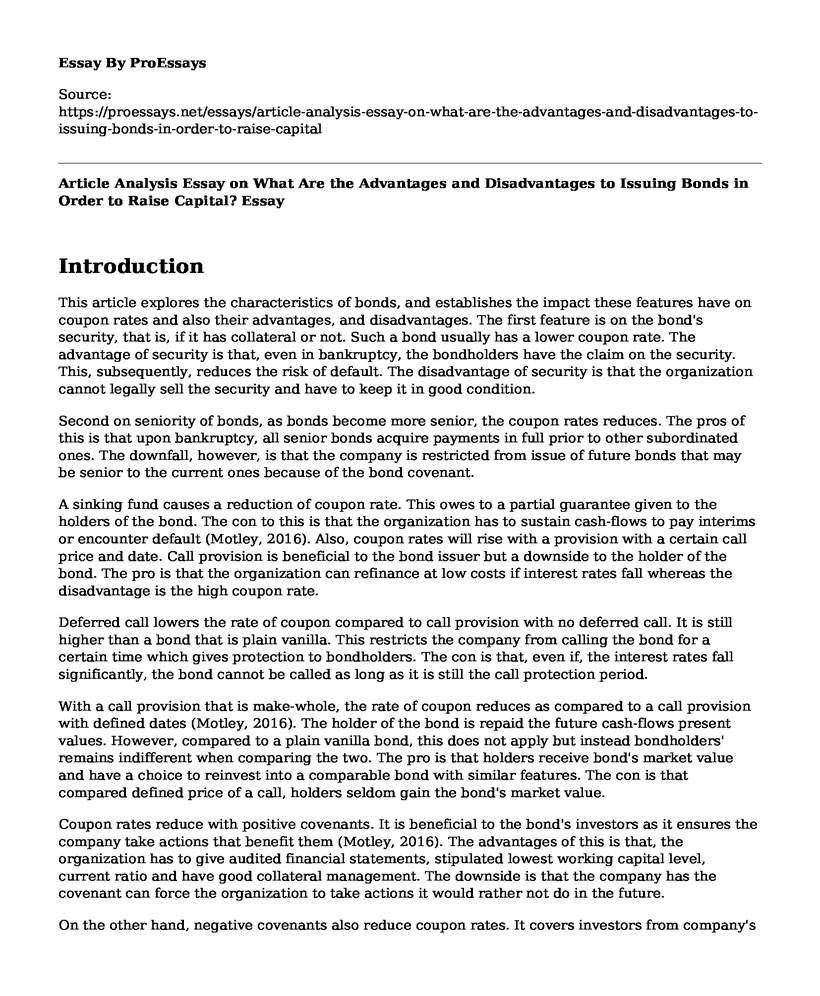Introduction
This article explores the characteristics of bonds, and establishes the impact these features have on coupon rates and also their advantages, and disadvantages. The first feature is on the bond's security, that is, if it has collateral or not. Such a bond usually has a lower coupon rate. The advantage of security is that, even in bankruptcy, the bondholders have the claim on the security. This, subsequently, reduces the risk of default. The disadvantage of security is that the organization cannot legally sell the security and have to keep it in good condition.
Second on seniority of bonds, as bonds become more senior, the coupon rates reduces. The pros of this is that upon bankruptcy, all senior bonds acquire payments in full prior to other subordinated ones. The downfall, however, is that the company is restricted from issue of future bonds that may be senior to the current ones because of the bond covenant.
A sinking fund causes a reduction of coupon rate. This owes to a partial guarantee given to the holders of the bond. The con to this is that the organization has to sustain cash-flows to pay interims or encounter default (Motley, 2016). Also, coupon rates will rise with a provision with a certain call price and date. Call provision is beneficial to the bond issuer but a downside to the holder of the bond. The pro is that the organization can refinance at low costs if interest rates fall whereas the disadvantage is the high coupon rate.
Deferred call lowers the rate of coupon compared to call provision with no deferred call. It is still higher than a bond that is plain vanilla. This restricts the company from calling the bond for a certain time which gives protection to bondholders. The con is that, even if, the interest rates fall significantly, the bond cannot be called as long as it is still the call protection period.
With a call provision that is make-whole, the rate of coupon reduces as compared to a call provision with defined dates (Motley, 2016). The holder of the bond is repaid the future cash-flows present values. However, compared to a plain vanilla bond, this does not apply but instead bondholders' remains indifferent when comparing the two. The pro is that holders receive bond's market value and have a choice to reinvest into a comparable bond with similar features. The con is that compared defined price of a call, holders seldom gain the bond's market value.
Coupon rates reduce with positive covenants. It is beneficial to the bond's investors as it ensures the company take actions that benefit them (Motley, 2016). The advantages of this is that, the organization has to give audited financial statements, stipulated lowest working capital level, current ratio and have good collateral management. The downside is that the company has the covenant can force the organization to take actions it would rather not do in the future.
On the other hand, negative covenants also reduce coupon rates. It covers investors from company's actions that can cause them harm. Such would include rising dividends beyond a certain level. The company can, also, not issue bond superior to the current ones and cannot resell collateral. The con is that this covenant restricts the organization's actions.
A conversion decreases the rate of coupons even though this company is private not public. This features allows investor of the bond to benefit in case the company decides to go public. The con is that the organization sells equity at a discounted rate (Motley, 2016). Lastly, for a floating coupon rate, if interest rates increase, the firm has to subsequently pay higher rates and vice versa.
References
Motley Fool Staff. (2016, January 10). What Are the Advantages and Disadvantages to Issuing Bonds in Order to Raise Capital? Retrieved from https://www.fool.com/knowledge-center/advantages-and-disadvantages-to-issuing-bonds-in-o.aspx
Cite this page
Article Analysis Essay on What Are the Advantages and Disadvantages to Issuing Bonds in Order to Raise Capital? . (2022, Dec 14). Retrieved from https://proessays.net/essays/article-analysis-essay-on-what-are-the-advantages-and-disadvantages-to-issuing-bonds-in-order-to-raise-capital
If you are the original author of this essay and no longer wish to have it published on the ProEssays website, please click below to request its removal:
- Taxes and Unemployment Benefit Essay
- The African Development Bank (AFDB) Overview Paper Example
- Technology and Innovation in Banking and Finance Essay Example
- Essay Example on Belgium Military Budget: 2010-2018 Analysis
- Essay Sample on Corporate Accounting Fraud: A Growing Problem
- Free Report Example on Improving Living Standards Through Adequate Housing
- Free Essay Example on Medical Claims Fraud: Billions Lost Annually







